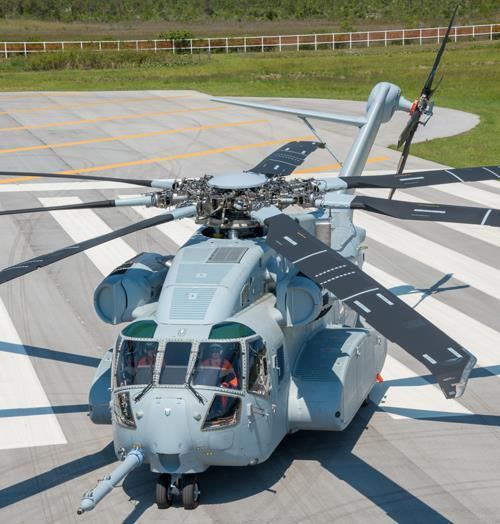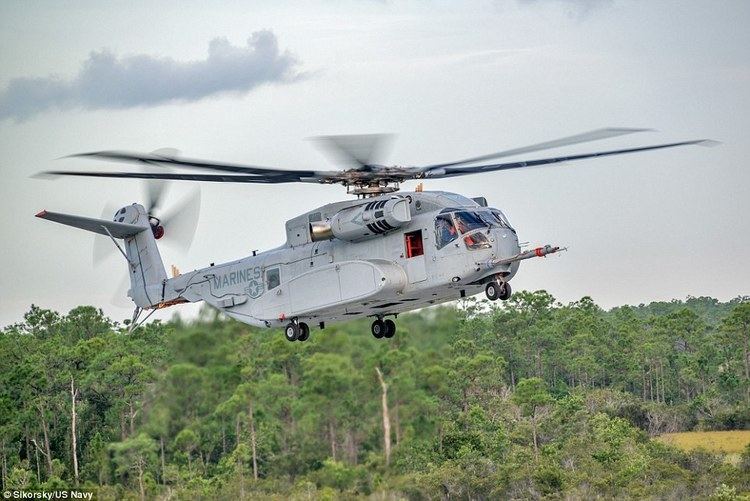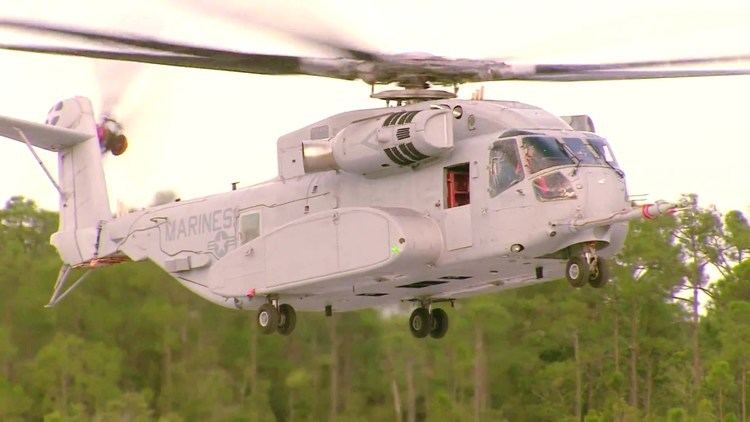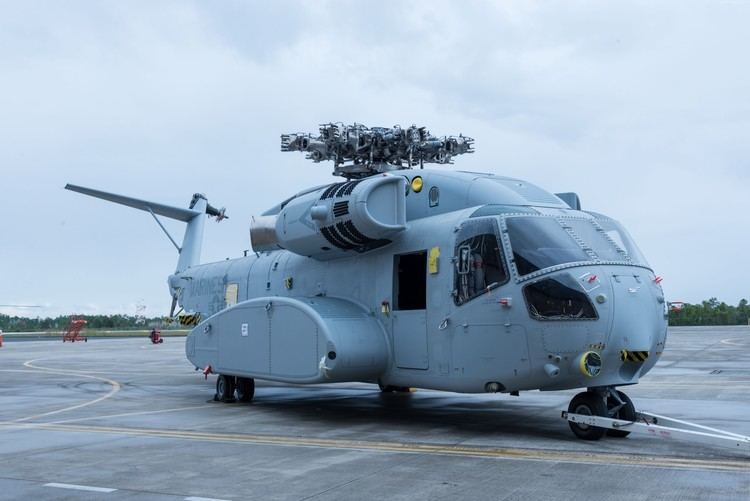Wingspan 24 m | First flight October 27, 2015 | |
 | ||
Sikorsky ch 53k king stallion lifts first external load
The Sikorsky CH-53K King Stallion is a large, heavy-lift cargo helicopter currently being developed by Sikorsky Aircraft for the United States Marine Corps (USMC). The design features three 7,500 shp (5,590 kW) engines, new composite rotor blades, and a wider aircraft cabin than previous CH-53 variants. It will be the largest and heaviest helicopter in the U.S. military. The USMC plans to receive 200 helicopters at a total cost of $25 billion. Ground Test Vehicle (GTV) testing started in April 2014; flight testing began with the maiden flight on 27 October 2015.
Contents
- Sikorsky ch 53k king stallion lifts first external load
- H 53 background
- CH 53K
- Design
- Specifications CH 53K
- References

H-53 background
The CH-53 was the product of the US Marine Corps' "Heavy Helicopter Experimental" (HH(X)) competition begun in 1962. Sikorsky's S-65 was selected over Boeing Vertol's modified CH-47 Chinook version. The prototype YCH-53A first flew on 14 October 1964. The helicopter was designated "CH-53A Sea Stallion" and delivery of production helicopters began in 1966. The CH-53A is equipped with T64-GE-6 shaft turbine and has a max gross weight of 46,000 lb (20,865 kg).

Variants of the original CH-53A Sea Stallion include the RH-53A/D, HH-53B/C, CH-53D, CH-53G, and MH-53H/J/M. The RH-53A and RH-53D were used by the United States Navy for minesweeping. The CH-53D included a more powerful version of the General Electric T64 engine, used in all H-53 variants, and external fuel tanks. The US Air Force's HH-53B/C "Super Jolly Green Giant" were for special operations and combat rescue. The Air Force's MH-53H/J/M Pave Low helicopters were the last of the twin engined H-53s and were equipped with extensive avionics upgrades for all weather operation.

In October 1967, the US Marine Corps issued a requirement for a helicopter with a lifting capacity 1.8 times that of the CH-53D and would fit on amphibious assault ships. Before this Sikorsky had been working on an enhancement to the CH-53D, under the company designation "S-80", featuring a third turboshaft engine and a more powerful rotor system. Sikorsky proposed the S-80 design to the Marines in 1968. The Marines considered this a good, quick solution, and funded development of a testbed helicopter. Changes on the CH-53E also included a stronger transmission and a fuselage stretched 6 feet 2 inches (1.88 m). The main rotor blades were changed to a titanium-fiberglass composite. A new automatic flight control system was added. The tail configuration was also changed to a larger vertical tail with the tail rotor tilted slightly to provide some lift in hover.
In 1974, the initial YCH-53E first flew. Following successful testing the initial production contract was awarded in 1978, and service introduction followed in February 1981. The US Navy acquired the CH-53E in small numbers for shipboard resupply. The Marines and Navy acquired a total of 177. For the airborne mine countermeasures role, the Navy later ordered a CH-53E version designated "MH-53E Sea Dragon" with enlarged sponsons and fuel tanks for greater fuel storage. The MH-53E began to be used by the Navy in 1986. The Navy obtained 46 Sea Dragons.
CH-53K

The US Marine Corps had been planning to upgrade most of its CH-53Es to keep them in service, but this plan stalled. Sikorsky then proposed a new version, originally the "CH-53X", and in April 2006 the USMC signed a contract for 156 aircraft as the "CH-53K" valued at $18.8 billion with deliveries to be completed by 2021. The Marines were planning to start retiring CH-53Es in 2009 and needed new helicopters very quickly as some aircraft would start hitting their structural life limits in 2011-12. Flight testing of the CH-53K was expected to begin in 2011.
The CH-53K is a general redesign of the CH-53E. The main improvements are new engines and cockpit layout. The CH-53K will have over twice the lift capacity and radius of action of the CH-53E, and a wider cargo hold to allow it to carry a Humvee internally. The CH-53K will feature new stubby composite sponsons to cut overall width, giving the helicopter a narrower footprint for shipboard operations. It will also be equipped with a new composite rotor blade system, with technology similar to that currently found on the UH-60 Black Hawk helicopter. The CH-53K will use the General Electric GE38-1B engine. This engine beat out the Pratt and Whitney Canada PW150 and a derivative of the Rolls-Royce AE 1107C-Liberty used on the V-22 Osprey.
Sikorsky has announced its major subcontractors: Aurora Flight Sciences (main rotor pylon), Exelis Aerostructures (tail rotor pylon and sponsons), GKN Aerospace (aft transition), Onboard Systems International (external cargo hook system), Rockwell Collins (avionics management system), Sanmina-SCI Corporation (Intercommunications System), and Spirit AeroSystems (cockpit and cabin).
In August 2007, the USMC increased its order of CH-53Ks from 156 to 227. In 2007, first flight was planned for November 2011 with initial operating capability (IOC) by 2015. When the CH-53K enters service, it will serve as the USMC's heavy lift helicopter with the MV-22 (medium lift) and UH-1Y (light lift). RAND released a report in 2007 on seabasing that suggested a higher ratio of CH-53Ks to MV-22s would reduce deployment times from naval ships.
In 2008, design work was well underway. Progress was being made in weight reduction efforts to meet operational requirements. Increases in engine performance and rotor blade improvements are options to help meet requirements if needed. The rotor mast tilt angle was decreased and components shifted to ensure the center of gravity does not shift too far rearward as fuel is burned. The design requirements were 'frozen' in 2009-10 and not changed since.
On 22 January 2010, Sikorsky Aircraft opened a $20 million Precision Components Technology Center in Stratford, Connecticut which will focus on production of the CH-53K. This facility will produce the rotating and stationary swashplates, main and tail rotor hubs, and main rotor sleeves among other parts. On 3 August 2010, the CH-53K passed Critical Design Review (CDR), and the program is ready for test production. However, the IOC fielding date was deferred to 2018. Sikorsky had proposed to build four pre-production aircraft for operational evaluations.
On 4 December 2012, Sikorsky delivered the first CH-53K, a Ground Test Vehicle (GTV) airframe. It was put through many hours of powered ground checks. Preliminary tests included calibrating the aircraft's fuel system and attaching measuring devices at various test locations on the airframe to record temperature, aerodynamic loads, pressure, and vibrations. Two additional static ground test articles underwent structural testing at the company's main manufacturing plant in Stratford, Connecticut.
In January 2013, the program was estimated to cost US$23.17 billion after procurement of the planned 200 CH-53K helicopters. In April 2013, the U.S. Navy program manager commented that development of the CH-53K was "proceeding so well" that it might become operational ahead of schedule. Flight testing is planned for 2015 having been delayed for more than a year by faulty components.
On 31 May 2013, the Navy awarded Sikorsky a $435 million contract to deliver four prototype CH-53Ks for operational evaluation and mission testing; all four are expected to be delivered by March 2017.
The Israeli Air Force has shown interest in the CH-53K. In 2009, the service said it would evaluate the new variant after it flies. In August 2015, the Israeli Air Force formalized a requirement for the CH-53K heavy transport helicopter, listing the type as a "very high priority" item to enable the service to perform missions only the platform is capable of. Israel's current CH-53 "Yasur" fleet is to remain operational until 2025.
On 1 October 2013, Sikorsky issued an $8.5 million contract to Kratos Defense & Security Solutions for the design and development of maintenance training systems for the CH-53K. The contract includes a full-fidelity Maintenance Training Device Suite (MTDS) and a Helicopter Emulation Maintenance Trainer (HEMT) for the Marine Corps. The full-fidelity MTDS provides a true-to-life environment for training and evaluating the maintainers of multiple subsystems on the CH-53K platform. It supports maintenance training as well as remove-and-replace training for avionics systems, electrical systems, hydraulic systems, and other mechanical subsystems. The HEMT uses a 3D virtual environment to support maintenance training scenarios. It will provide Marine CH-53K Enlisted Aircrew and maintainers with an accurate environment to train functional tests, fault isolation, troubleshooting, and remove and installation for 27 subsystems.
On 24 January 2014, the CH-53K GTV ignited its GE38-1B engines and spun the rotor head without rotors attached. Engine ignition is a significant step after independent subsystems testing had been completed. Low-rate production is planned to proceed from 2015 to 2017. The CH-53K is planned to achieve initial operating capability (IOC) in 2019, with full-rate production commencing sometime between then and 2022. The USMC is planning for eight active CH-53K squadrons, one training squadron, and one reserve squadron. In April 2014, testing with blades attached began, and systems integration is to be next. Flight tests were to start in late 2014 and last 3 years. Four engineering aircraft are to each fly approximately 500 hours. The maiden flight has been delayed, due to challenges with the titanium quill shafts in the transmission system and gear box.
On 5 May 2014, General James F. Amos announced during the official rollout that the CH-53K will be called the "King Stallion".
On 27 October 2015, the CH-53K took its first flight.
Design
The CH-53K is a general redesign with new engines and cockpit layout. The CH-53K will use General Electric T408 (GE38-1B) engines rated at 7,500 shp (5,600 kW) each and will be able to fly 20 knots (37 km/h; 23 mph) faster than its CH-53E predecessor.
It will feature a new digital glass cockpit with fly-by-wire controls and haptic feedback, HUMS, a new elastomeric hub system, and composite rotor blades to improve "hot and high" performance. The split torque gearbox with quill shafts started development around 2007. The gearbox assembly including rotor hub and rotating control system weighs around 11,650 lb (5,280 kg), which is heavier than an empty Black Hawk helicopter. The split torque gearbox weighs 5,270 lb (2,390 kg). By comparison, the twin-engine Mil Mi-26 split torque gearbox weighs 8,020 lb (3,639 kg).
The CH-53K will also include an improved external cargo handling system, survivability enhancements, and improvements to extend service life. The cabin will be 30 ft (9.14 m) long by 9 ft (2.74 m) wide by 6.5 ft (1.98 m) tall. Its cabin will be 1 ft (30 cm) wider and 15% larger, but will have new shorter composite sponsons.
The CH-53K is to surpass the capability of the CH-53E by carrying nearly double the external payload of 27,000 lb (12,200 kg) over the same radius of 110 nmi (204 km). The CH-53K's payload reaches a maximum of 35,000 lb (15,900 kg). The CH-53K's maximum gross weight will be 88,000 lb (39,900 kg), which is increased over the CH-53E's 73,500 lb (33,300 kg). The CH-53K will keep approximately the same footprint as the CH-53E.
The CH-53K can carry two 463L master pallets, eliminating the need to break apart pallets between airlifter and helicopter.
Specifications (CH-53K)
* = data for K model. All others for E model.
Data from Sikorsky CH-53K sources, GE38-1B data, Flightglobal.com
General characteristics
Performance
Armament
